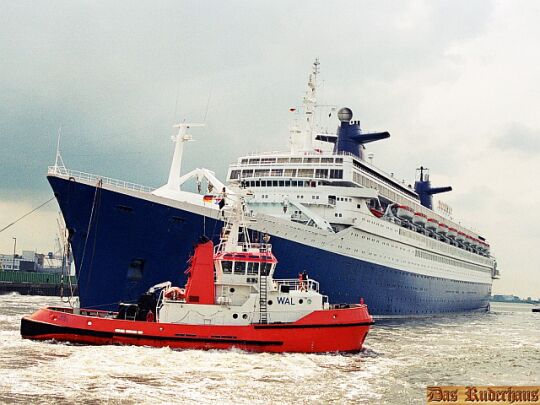ssMaritime
With Reuben Goossens
NTSB
Report Discloses NCL Failures re SS Norway Boiler Maintenance

The report clearly
describes that NCL was not efficient and in some ways were deficient in their
boiler operation; including poor maintenance and inspection by Norwegian all
being the probable causes of the deadly 2003 explosion on SS Norway, according
to findings by the National Transportation Safety Board. Tragically the boiler
explosion killed eight crewmen and seriously injured another 10 persons.
It was stated that
inadequate operations over a good number of years allowed material
deterioration and fatigue cracking to weaken the effected boiler, No. 23, the
NTSB determined after a lengthy investigation. In addition, inadequate boiler
surveys by Bureau Veritas contributed to the
accident, the safety board said. According to the investigators, the greatest
contributors to cracking were the thermal and pressure stress caused by firing
up and shutting down the boilers too quickly which was clearly outside the
guidelines, which should have been known by the chief engineers at the NCL head
office. Other factors ranged from questionable weld repairs, where foreign
materials were found, such as nuggets of copper, that should not have been
there, and a lack of adherence to water chemistry procedures.

In a statement, NCL
said it did not concur with all of the conclusions in the
“voluminous” NTSB report that took four and a half years to
complete. “But we are hopeful that its publication will help bring to a
close this tragic event,” said Colin Veitch,
president and
Bureau Veritas maintains it had applied its existing rules
concerning boiler inspection and testing. “In particular, the last
hydraulic test in July 2002 was conducted well above working pressure and
safety valve setting,” the classification society said in a statement.
Safety board
investigators said boiler No. 23, one of four, ruptured due to extensive
fatigue cracking. Cracks were detected at original welds beginning in the
1970s, and additional cracks were found on later occasions. These were
monitored and ground away, and then weld repairs were made to build up the
material thickness. Residual stresses in the weld repairs probably accelerated
the pitting and cracking, the NTSB said.
At some point,
copper was inappropriately introduced, possibly to mask (to hide) the cracks
during inspections, investigators theorized. A lack of adherence to water
chemistry composition by both the water chemistry subcontractors and NCL likely
led to pitting from oxygen corrosion, causing further weakening of the boiler.
According to the
NTSB report, between the late 1990s and 2002, several engineers (including one
engineer who wrote me some time back) expressed concern about the frequent
(incorrect - fast) start-ups and shutdowns required by the operating schedule
and the stress those caused on the boilers. On the morning of
After the explosion,
NCL decided to have the ship towed to

It is obvious that
Star Cruises and NCL have a great deal to answer for. The question I would like
to ask is this: Who were, and why was there a there a group of Asian engineers
in the engine room during one of her cruises not long before the explosion? I
received this information from one of the ships engineers who have now left the
company? Does NTSB know about them and did they have anything to do with the
copper being present? It is an obvious question being asked considering the
report although I am only going by what I have been told.
You can read the entire NTSB (pdf) report at http://www.ntsb.gov/publictn/2007/MAB0703.pdf.
Use
the Back button on your browser or Close the Page to return to the previous
page
or go to our INDEX
Who is the Author of ssMaritime?
Commenced
in the passenger Shipping Industry in May 1960
Also
visit my …
“Save The Classic Liners Campaign” & “Classic Ocean Voyages”